5 Ways Your School Facilities Impact Student Achievement
A great school facility is more than just a building kept in the best possible shape through routine maintenance, regular inspections, and other preventative work. Done well, it can create an ideal environment for academic achievement with research showing a direct impact on student learning.
“If we want to continue to increase student scores across the board, we have to first be honest and recognize that we need to reduce disparities across schools from the standpoint of the quality of the learning environment,” said Jeff Clemmons, director of Facility Services at TASB.
Finding ways to focus on the needs of students is always top of mind for high-performing boards and school districts. Investing in facilities can add up to better student health, attendance, behavior, and achievement. For teachers, the benefits include improved morale and instruction.
For Karen Shwind, president of the Texas School Nurse Organization and Health Services coordinator at New Braunfels ISD, there’s no doubt that facilities can have an impact on student learning, especially when trying to minimize chronic absences related to conditions like asthma.
“We always say that a healthy child is going to be your best learner,” she said. “Environmental factors can lead to — and think of those with respiratory issues, particularly our asthma population and then those with anaphylaxis — increased absences. If they’re not in school, they’re not learning.”
Creating a healthy learning environment not only helps minimize absenteeism, but it also impacts a school district’s budget.
“Looking at this from a performance standpoint for the school district, if you have high-functioning facilities, kids are in their seats in class, they’re there, and they’re learning,” said Gary Hutton, General Manager of Operations at Spring ISD. “That also means the district is getting attendance funding. So, there's student attendance, learning, and increased performance — they achieve more and get better scores — plus the schools are properly funded and that creates a sort of offset to the costs of any necessary upgrades. It’s a win-win.”
How the Condition of School Buildings Affects Education
Across Texas, there are more than 9,000 campuses, with an average age of more than 40 years old. As the state adds roughly 80,000 students each year (about the seating capacity of the Darrell K Royal — Texas Memorial Stadium at the University of Texas at Austin) and new facilities come online, that average age is dropping, but repairs, renovations, and modernizations are still needed for many buildings to meet the needs of a 21st-century education.
The idea that school building conditions can affect student achievement isn’t new. A 2007 study, The Relationship Between School Building Conditions and Student Achievement at the Middle School Level in the Commonwealth of Virginia, is one of many that has found that student achievement is connected to a building’s condition. Students perform better in newer or recently renovated buildings than they do in older buildings.
“What’s fascinating about this study is that when you divide the facilities up between standard and substandard, you're looking at a 6.1 percent difference in students passing English alone,” said Clemmons, “that’s noteworthy because English affects all other academic areas.”
The U.S. Department of Education acknowledged the impact of well-maintained facilities on learning and teaching in a 2014 letter. "When classrooms are too hot, too cold, overcrowded, dust-filled or poorly ventilated, students and teachers suffer," it wrote.
How School Facilities Affect Learning Outcomes
The environmental conditions that play a role in student success can be roughly broken down into five broad categories:
- Acoustics and noise
- Air quality
- Lighting
- Temperature control
- Classroom size and space
Acoustics and Noise
Loud noises are distracting and even stressful. Noise impairs the ability of teachers to teach and students to learn. Common sources for these distractions are heating and ventilation units, neighboring classrooms, nearby facilities, airplane flight paths, and road traffic. Research shows that classrooms that reduce external noise have more engaged and higher achieving students compared to those in noisier school environments.
“There’s one study out there that looked at reading test scores from two schools with matching demographic factors,” said Clemmons. “The difference was that one school was in the flight path of an airport, while the other was in a quiet neighborhood. Students from the school in the flight path had significantly lower reading scores than those at the quieter school.”
Classroom noise is of particular concern for students with hearing loss or attention deficits. School buildings that can buffer classrooms from external noise sources can improve student outcomes.
Air Quality
Indoor air quality (IAQ) is another key factor. Poor air quality contributes to absenteeism, particularly for students with asthma. Increased absences and difficulty concentrating while in school may mean student achievement measures are less about ascertaining learning and more a gauge of a student’s health and their ability to focus.
Research also indicates that some schools suffer from what has been dubbed “sick building syndrome,” a collection of symptoms that includes lethargy, dry skin, and headaches. It affects the absenteeism and performance of both students and teachers.
Additionally, poor IAQ means these buildings have more bacteria, viruses, allergens, and indoor pollutants from office equipment, cleaning products and pesticides, flooring materials, paints, and adhesives — all of which can contribute to childhood illness and more missed days of school.
“The problems with air quality can be very unique. You could have a student with a reaction to an air freshener in a classroom — a plug-in — we remove that plug-in and the problem goes away,” said Schwind. “But if you're talking about a major moisture issue underneath the entire building creating mold issues, well that's a totally different circumstance that involves a lot of mechanics in eliminating.”
One area Hutton sees as an underappreciated IAQ vector is carpeting. “Whether it’s flu or COVID, or just allergens, kids are bringing these things in from outside, and they’re settling in the carpet and then getting stirred up throughout the day,” said Hutton. “So, I think school districts can do a better job of effectively cleaning carpets regularly and replacing them regularly, too.”
Lighting
Research shows that natural lighting boosts the morale of teachers and students. It also reduces off-task behavior and improves test scores. Environments with little natural light have been shown to produce less than desirable results.
Many schools, particularly those built in the 1980s and 1990s, were built like bunkers according to Hutton, with little natural light getting in. “At the time, that’s what you built. You wanted to avoid heat build-up and see energy savings, so windows were limited. It was a reaction to the environmental challenges of the time,” Hutton said. “But then kids were boxed-in under fluorescent lights and didn’t really see natural light all day and people wondered why attendance was dropping.”
“We see students who have migraines triggered by fluorescents or by a bulb that flickers or depending on the athletic season with, we might see students with concussions, and sometimes the lighting can be an issue for them as well,” said Schwind. “All of these things can increase absences and decrease student performance even if they’re still in the classroom.”
Now technology exists to bring natural light to the learning environment, even in older facilities that may not have had many options for external light. It’s possible to replicate natural light using LEDs. With lighting accounting for about 23 percent of a district’s energy cost, according to Clemmons, switching to LEDs that replicate natural light when external light isn’t practical not only improves student outcomes, but it also saves money.
“There’s a study out there that shows that students with the most exposure to natural daylight progressed 20 percent faster in math and 26 percent faster in reading,” said Clemmons. “That is a huge differential. It's not one or a 1.2 percent faster, it is a huge growth in the results.”
Temperature Control
Anyone who has worked in an office that is too hot or too cold knows how difficult it can be to concentrate when you’re uncomfortable. The temperature affects your engagement levels and overall productivity no matter what age you are. Teacher performance and student achievement are both affected.
“When you go into a classroom — my daughter, for instance, takes a coat to school every day because she knows she's going to be cold when she gets to class — and it’s not comfortable, that takes the mind off learning,” said Clemmons, “It's a distraction. That’s a function of the facility.” According to the best analyses, the ideal temperature range for effective learning in reading and math is between 68 and 74 degrees.
Classroom teachers know how to keep their room comfortable and primed for learning. For them to have the fine-tuned control necessary, they need to be able to adjust the temperature in their own classroom. If room-level control isn’t possible, schools should try to allow for temperature control of small blocks of classrooms that receive similar amounts of sunlight and exposure to outside temperatures.
Classroom Size and Space
Classrooms with adequate space to spread out allow teachers to reconfigure seating arrangements and enable varied teaching methods. They also make it possible to create private study areas and smaller learning centers that reduce visual and auditory interruptions.
Overcrowding has consistently been linked to increased aggression in students, decreased engagement, and lower levels of learning. Classrooms that offer flexibility and reconfiguration are associated with increased student engagement and learning.
The classic layout of an 800 square foot room with rows of desks isn’t always the correct set up. As pedagogy changes, so have classroom layouts. Flexible space is important to ensuring that students can work together, collaborating and communicating effectively to solve problems.
“As teaching methods change, so must our approach to improving our school facilities,” said Clemmons. “Flexibility is key.”
Making Sure Your School Facilities Meet the Challenges of the 21st Century
School districts must make careful assessments to determine when aging facilities need major renovation or replacement. But if the goal is to stretch limited budgets or postpone the need for a costly bond program, regular and proactive maintenance is essential. An older facility that’s been updated and maintained well can still meet the needs of today’s students, Clemmons said.
“A dirty building or a building that has not been properly maintained could negatively impact student performance — regardless of the age of the facility,” he said. As long as [the building] is maintained, it’s clean, and it has been renovated to create a comfortable 21st-century learning environment, that's going to provide us with the environment most conducive to educational advancement.”
Again, the data shows a clear connection between maintenance and student attendance and achievement. Schools without major maintenance backlogs have a higher average daily attendance (ADA) of 4 to 5 students per 1,000 on average, according to the Environmental Protection Agency. They also have an annual dropout rate that’s lower by 10 to 13 students per 1,000. And test scores improve, too, as building conditions improve, says the EPA. Studies show test scores can go up by 3 to 17 percent.
“From a district standpoint, the goal is always to create an environment where teachers can teach to the best of their ability and students can learn to the best of their ability. Your buildings shouldn’t hinder those things,” said Hutton.
This article was originally published Nov. 30, 2022. It was updated Feb. 14, 2024.





